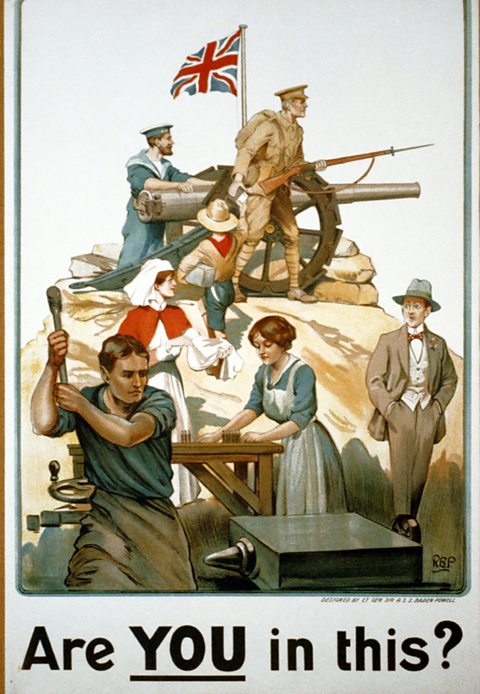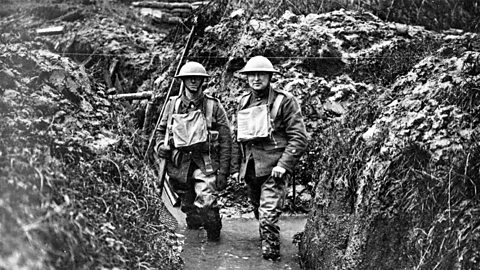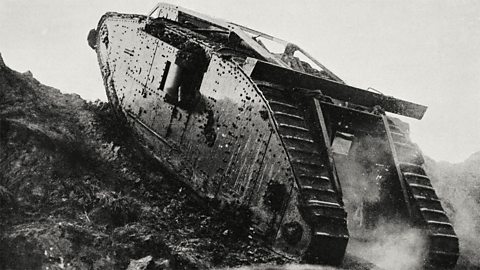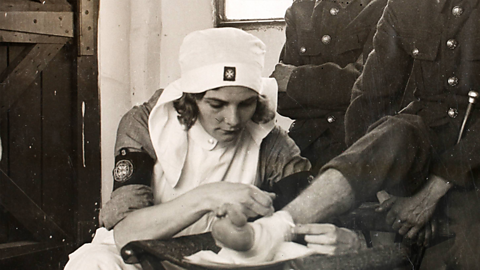Key points
- At the start of World War One, the UK launched a huge recruitment campaign, recruiting soldiers from all around the UK and the British Empire.
- Life in the trenches was extremely difficult, uncomfortable and dangerous.
- Soldiers in the trenches were supported by labourers and medics.
- New weapons and technology changed how wars were fought, prolonging World War One for four years, until 1918. It resulted in the deaths of millions of people.
- The first day of the Battle of the Somme was the deadliest day in the history of the British army.
Video about life on the front line during World War One
Indian soldier: We had travelled by boat from India to Southern France. We were given our weapons, Lee-Enfield rifles, that were standard for the British army, but we were unfamiliar with them. We travelled to the Western Front on the northern border of France and Belgium. I remember being nervous, but proud. I was doing my duty and bringing honour to my family at home in India, but it was not easy. Lots of Indian commanding officers died and the new British officers didn't speak the same language as us.
It was so muddy, so cold. The fighting was brutal. We lost so many men.
British soldier: I remember walking to the front, passing all the injured and exhausted soldiers on their way home to some rest back at the camp. We were usually on the front line for eight days at a time. The trenches were long and narrow. They were supposed to protect us from the German machine guns and artillery bombardment from the air. We tried to make attacks over the top of the trenches, our bayonets fixed onto our rifles. We ran across No Man's Land, the area between our trenches and the enemy's.
It was so muddy, the land filled with craters and barbed wire. It made it almost impossible to move forwards towards the German trenches.
Nurse: There were so many injured and killed in those raids. Every day we had so much to do. We worked in 12-hour shifts. Trenches were filthy and often filled with mud and water. So trench foot and trench fever took their toll as well. Many others had fevers and infections. The field hospitals were always full. There was a never-ending stream of wounded soldiers with injuries like nothing we'd ever seen before. But we just had to carry on, working to save as many lives as we could.
How were soldiers recruited to the British army?

The UK only had around 700,000 soldiers in the Army when war broke out in 1914. They needed to launch a mass recruitmentPersuading people to join up to the army. campaign.
Lord Kitchener was appointed as the Secretary of State for War. This meant he was responsible for persuading volunteers to join up to the Army. A huge poster campaign was launched, with the aim of reaching as many potential soldiers as possible.
The recruitment campaign was hugely successful. Within six weeks of the outbreak of war, nearly 500,000 British men had volunteered to join the Army. By the end of 1915, 2.5 million men had signed up.
Recruitment also took place in British colonyA group or country controlled by another country.. Most of the fighting took place in Europe, but people from all over the world fought for the UK. The table below shows the number of soldiers who served from different parts of the British Empire over the course of the war. These figures are from 'The Statistics of the Military Effort of the British Empire during the Great War 1914-1920'.

| Country | Number of soldiers |
|---|---|
| UK | 5,704,416 |
| India | 1,440,437 |
| Canada | 628,964 |
| Australia | 412,953 |
| South Africa | 136,070 |
| New Zealand | 128,825 |
| Other colonies | 134,837 |
What were trench conditions like?
Trenches were normally about two metres deep, with wooden supports on either side. They had a dug out where soldiers could rest or try to get some sleep. The area between the enemy trenches was called no man’s land.
Trenches were dug in low land. This meant that they often flooded during heavy rain, creating waterlogged and muddy conditions. When soldiers had to cross no man’s land, they faced enemy fire, as well as muddy ground covered with barbed wire and shell holesHoles in the ground caused by explosions. They could be very deep and wide, making it difficult to cross no-man’s land. that was difficult to navigate.

Soldiers’ clothing often became infected with lice due to the lack of washing facilities. As conditions were so cramped, they would quickly spread amongst the soldiers. Bites from lice were itchy and uncomfortable. Lice could also spread a disease called trench feverA disease caused by infected lice. It caused a high temperature, headaches and joint pain.. Dead bodies and food rations attracted rats into the trenches, who could bite soldiers and spread disease.
Trench foot was incredibly common. It was caused by soldiers not taking off their boots and their feet became blistered, losing feeling in nerves and sometimes needing to be amputated.
Shell shock was a mental health condition caused by soldiers being so frightened of the constant explosions going on around them. Some soldiers were accused of being cowardly and were shot by their own peers when they refused to go over the topTo go up out of the trenches and into no-man’s land to attack the opposing side. into no man’s land. It is now believed that many of these soldiers were actually suffering from shell shock.
How do we know what life in the trenches was like?
Many soldiers wrote letters home to describe what life on the front line was like. However, these letters were often censored by the Army to ensure they couldn’t give away important information to the enemy. This means they sometimes didn’t give the full picture.
Many soldiers wrote poetry about what they were living through. There are many well-known poets from this era, such as Wilfred Owen, Siegfried Sassoon and John McCrae. These poems sometimes give a chilling account of what conditions were like.
Soldiers who were injured were sent home to rest and recover. They were able to tell their families what conditions were like.
It is not clear what impact stories from the front line had on recruitment, but by 1916 conscription was introduced, making it mandatory for all able-bodied, single men between the ages of 18 and 40 to join the Army.
By the end of World War One, it is thought that 1.1 million men died fighting for the UK, including men from Australia, New Zealand, Canada and India.
What new weapons were used in World War One?
Before World War One, armies had often relied heavily on cavalrySoldiers on horseback.. At the start of World War One, many new and advanced weapons had been developed that would change warfareMethods and tactics used to fight a war. forever. Machine guns, grenades, gas, tanks and planes were used in World War One with devastating effects.
Machine guns
These weapons could fire up to 600 bullets per minute. They were heavy and needed two people to operate them. Machine guns were responsible for tens of thousands of deaths as soldiers tried to cross no man’s land walking towards enemy trenches.
Grenades
Grenades were produced in their millions in World War One. Soldiers would try to throw them into enemy trenches as they crossed no man’s land to cause explosions.
Gas
Several types of gas were used as a weapon in World War One. Mustard gas caused severe blistering and burns. Four thousand British soldiers were killed by mustard gas. Chlorine gas had a pepper like smell and caused breathing difficulties. It was less deadly but caused over 150,000 casualties.
Tanks
Tanks were used for the first time at the Battle of the Somme in France. They were slow, travelling at about five miles per hour, and quite unreliable. Many broke down or got stuck in the mud.However, they were good at providing soldiers with protection from machine gunfire, as they could walk behind the tanks as they crossed no man’s land. The tanks could also attack German defences, such as machine-gun posts.
Planes
Planes were used for surveillance over enemy lines. They could provide valuable information to help Army leaders make decisions about where to attack enemy defences or where artilleryPowerful weapons used to fire at targets a distance away. fire should be directed. Planes would be used to shoot at targets on the ground, although they were not capable of carrying heavy bombs. Pilots were also involved in dogfightsA fight in the sky involving two or more planes at short range., trying to shoot each other down.

Who worked on the Western Front?
During World War One, the millions of soldiers who fought on the Western Front were supported by labourers and medical staff. As many soldiers died in the Battle of the Somme, British military leadership asked for thousands of labourers to be recruited.
These workers did essential non-combat work to support the front-line soldiers, such as unloading ships, repairing roads and railways and digging trenches. They remained on the Western Front when the war ended to clear mines, recover bodies, and fill in miles of trenches. Often these men were from the British Empire but 100,000 of them were recruited from China.

Alongside the soldiers and labourers were the medical staff. By 1918, half of the UK’s registered doctors were serving in the war, mostly on the Western Front. These doctors were supported by female nurses. Although many were professionals who had worked as nurses before the war, some were volunteers who had very little training. These volunteers weren’t always warmly welcomed and spent most of their time cleaning. They were rarely allowed to dress wounds or administer drugs until later in the war.
You can read more about how women contributed to the war effort in this guide.
The Battle of the Somme
In 1916, the French army was under heavy attack from German soldiers in a town called Verdun. Verdun was a key location in the French defences. It had defensive forts and would have been a huge psychological loss to France if it had been captured.
The British army started an offensive in the trenches near the river Somme, forcing the German army to divert some of their troops away from Verdun.
For seven days, the British fired 3 million shells at the German trenches, aiming to destroy their defences. British miners had also tunnelled under no man’s land and set huge explosives to detonate on the morning of 1 July, just before British soldiers crossed no man’s land.
On 1 July 1916, British soldiers were ordered to walk across no man’s land to capture the German trenches as their own. This was incredibly dangerous for the soldiers, but they thought they had already sufficiently damaged the German trenches.
Their plan had failed. The German soldiers had taken shelter in underground bunkers made of concrete, protecting themselves from the shellfire. When the British soldiers went over the top into no man’s land, German machine guns opened fire.
By the end of the first day of the battle, 19,240 British soldiers had been killed, and 38,230 were injured. It was the deadliest day in the history of the British army.
New tactics
As the battle went on, new tactics were developed that helped the British army to be more successful. These included:
- The creeping barrage: Soldiers crossed no man’s land behind shell fire, so they were masked by smoke and debris. This made it harder for German soldiers to see them.
- Tanks: These were used for the first time at the Somme, providing protection and support for soldiers crossing no man’s land.
- Aerial reconnaissance: Pilots flew over German trenches to gather information about their defences and number of soldiers.
- Timing of attacks: Rather than attacking early in the morning, as they had done on 1 July, the British began attacks late in the morning. This meant there was less time in the day for the German army to launch a counterattack.
The Battle of the Somme eventually ended in November 1916 and Verdun was saved; it remained in French hands. Although the war continued for another two years, many of the tactics and developments at the Somme were crucial to the German surrender of November 1918.
Test your knowledge
Play the History Detectives game! gamePlay the History Detectives game!
Analyse and evaluate evidence to uncover some of history’s burning questions in this game.

More on World War One
Find out more by working through a topic